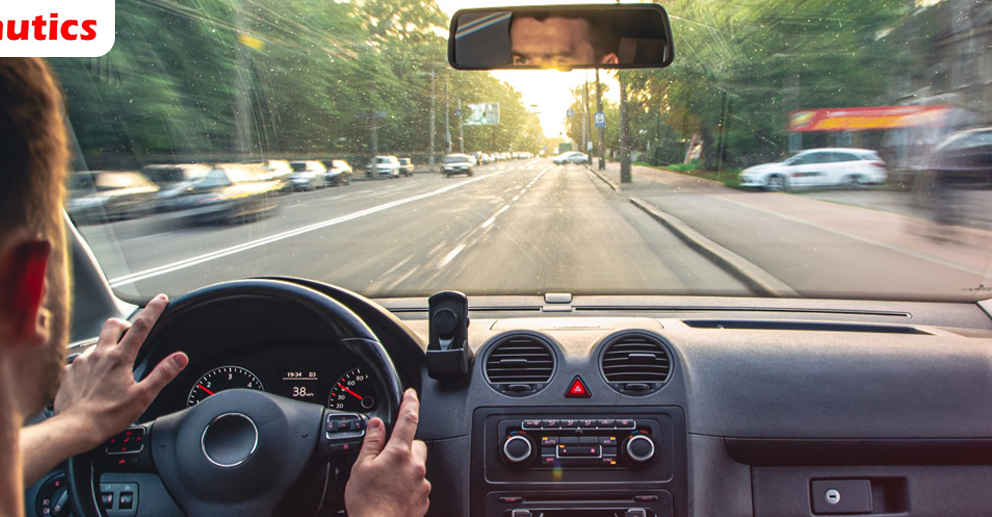Reckless driving kills almost 100 people every day in the United States alone! So can you imagine the global death toll due to reckless driving? It is time to address this very serious issue that claims thousands of lives each year. When it comes to transportation fleets, a reckless driving charge not only leads to a loss in revenue but can damage your credibility permanently, which has massive implications on your business.
Connected Fleet can help curb reckless driving to a large extent – this article gives a detailed insight into it. Here goes:
- What is reckless driving?
- What are some examples of reckless driving?
- Are aware of some real-world reckless driving stats and facts?
- What are the differences between careless, aggressive, and reckless driving?
- What are the consequences of reckless driving?
- What leads to reckless driving accidents?
- What is the legal aspect of reckless driving?
- Is reckless driving a violent crime?
- How can a fleet tracking system prevent reckless driving behaviour?
What is reckless driving?
The Federal Motor Carrier Safety Administration’s Safety Measurement System defines reckless driving as “driving a motor vehicle in willful or wanton disregard for the safety of persons or property”. When someone consciously or intentionally ignores safety rules of the road and operation of the vehicle, with the knowledge that it can cause damage, it means they are driving recklessly. Did you know that 33% of car accidents in the United States result in a fatality?
What are some examples of reckless driving?
To prevent reckless driving, it is imperative to ensure that your drivers understand what it means, so they can take steps to avoid it. Here are some instances:
- Ignoring traffic signs and signals, while disregarding oncoming traffic, right-of-way for vehicles and pedestrians, and instructions by traffic personnel on the road.
- Not stopping at red lights and passing by stop signs.
- Going over specified speed limits, passing on blind curves, and swerving in and out of lanes.
- Weaving in and out through traffic and tailgating frequently.
- Racing vehicles on the road or overtaking dangerously/from the wrong side.
- Driving into areas where vehicles aren’t allowed such as sidewalks or pavements.
- Crossing a two-lane highway or double yellow lines on the highway.
- Passing school buses when they clearly have their stop signs down.
- Driving under influence of drugs or alcohol.
- Talking on the phone or texting while driving.
- Going around railroad barriers.
- Fleeing from law enforcement.
Some reckless driving stats for your knowledge!
In some places, reckless driving is often labelled as a misdemeanour crime, and the charge stays on your driving record permanently. Here are some stats to give you a clearer picture of where things stand:
- An AAA Foundation for Traffic Safety poll in the US found that 87% of drivers engage in reckless driving.
- If you fall asleep at the wheel and cause someone’s death, it is classified as reckless driving in Louisiana.
- Want to evade police in Florida? Be prepared to have a “reckless driving” charge slapped on you.
- Reckless riding of an animal in Hawaii qualifies as reckless driving.
- If you intentionally make a vehicle airborne in Illinois, you will be in trouble.
- Steer clear from racing or even betting on races if you are in Nevada and New Hampshire, as these activities fall under the realm of reckless driving. You can land in jail or end up paying a heavy fine.
- Minnesota reckless driving laws prohibit racing even if you maintain or go below the speed limit.
- Go above 80 mph in Virginia and your driving is termed as reckless.
These stats give you a better idea about the seriousness of the issue – reckless driving is not to be taken lightly under any circumstances.
What is the difference between reckless driving and aggressive driving?
The two offenses are similar in nature, so the terms are often used interchangeably. But there are some variations between them. For instance, if you go over the speed limit, pass on a grade or on a curve, overtake two vehicles abreast, pass a stopped school bus, drive with obstructed views, don’t use proper signals, fail to yield right-of-way, drag race, etc. it qualifies as reckless driving.
Aggressive driving on the other hand is when someone intentionally wishes to harass, harm, or injure someone. It can include speeding, driving on the wrong side of the road or outside designated lanes, incorrect passing/overtaking, not yielding right-of-way, disobeying traffic signals, and stopping on a highway.
Reckless driving only requires that you engage in unsafe driving behaviour, which might not be to intimidate or harm others. The difference here is intent, but both are typically considered misdemeanors, which mean a criminal charge.
What is the difference between careless driving and reckless driving?
Both terms refer to a driver who doesn’t follow the rules of the road, but here too, it is the intent that makes the difference. But keep in mind that both offenses can lead to serious accidents, license suspension, exorbitant fines, and demerit points on the driver’s license. Careless driving is a civil traffic violation that includes not paying attention to the road, speeding, disobeying traffic signs and lights, swerving into wrong lanes, harsh braking, improper overtaking, and also texting while driving. It is not a criminal offense as there is no criminal intent involved, but it can prove to be costly. If the driver works for your fleet management company, you could end up with hefty fines and penalties, not to mention your reputation can come under the scanner as well.
Reckless driving is a criminal offense, which can carry a jail sentence, in addition to huge fines, high insurance premiums, and demerit points on a driver’s license. The reason is that it involves conscious or deliberate disregard for the safety of people or property. Some instances of reckless driving include tailgating, going over speed limits, not following traffic rules and signs, randomly changing lanes, racing other vehicles, driving under influence, endangering the lives of other drivers and pedestrians, and evading law enforcement. If the driver belongs to a fleet management company, there could be a case of negligent entrustment as well.
What are the consequences involved in reckless driving cases?
Reckless driving can have devastating consequences, which can lead to injuries, or even worse – loss of life. Take a look:
Losing your license
Your drivers’ license can be suspended if they are found guilty of engaging in reckless driving behaviour on multiple occasions. In some cases, the license could be permanently revoked.
Collisions
When a driver departs their travel lane into oncoming traffic, there is a high chance of head-on collisions. Be it an aggressive attempt to pass on a two-lane road or impaired driving, it can lead to accidents that claim lives or leave victims severely injured. Another type of collision happens when reckless drivers zoom through intersections or ignore traffic signals – they could collide with the side of another vehicle, or vice versa. Needless to say, the injuries sustained by victims could be immense. Reckless drivers, who tend to tailgate, are often unable to stop their vehicles in time to avoid colliding with a car or truck in front. This time, the leading vehicle occupants who generally endure the worst of the collision – effects could be severe whiplash and brain injury.
Accidents involving pedestrians and bicycles
The problem is that a reckless driver can’t stop for someone on a crosswalk or give a cyclist enough space when they pass. The result is that both the pedestrian and cyclist are struck down, so they are gravely injured or are in danger of losing their lives.
Paying hefty fines and more insurance premiums
If drivers are caught by law enforcement while indulging in reckless behaviour that has resulted in an accident, they are likely to receive a ticket, while you have to bear the cost of fines. Moreover, if your drivers engage in reckless driving, the accident risk goes up, so insurance companies don’t want to bear the burden. It means you have to pay more insurance premiums – the increase is significant.
An ignition interlock device is installed
If your driver is operating the vehicle under influence, you might have to install an ignition interlock device on the vehicle (as instructed by the law). It means reduced driving privileges, which includes a restricted driving license that lets the vehicle operate at specific times. This arrangement won’t benefit your fleet at all!
Spending time in jail
If your driver’s reckless behaviour has led to an accident that caused death or serious injuries, there are high chances of jail time.
Credibility issues
If a driver belonging to your fleet is caught engaging in reckless behaviour that leads to an arrest and consequent jail time, your company’s reputation will be affected negatively. Customers will lose the trust and faith they placed in your organization and you could end up losing some business to your competition.
What are the causes of common reckless driving accidents?
There is no single cause of a reckless driving accident as it involves one or more bad decisions by the driver. However, some of the common causes are tailgating, not stopping at red lights or stop signs, going over the speed limit, harsh braking, driving under influence, not using headlights during adverse weather conditions, not using turn signals while changing lanes or turning, and indulging in distracted driving.
Know about the legal aspect of driving recklessly
As mentioned above, reckless driving is a criminal offense, so you get more than a slap on the wrist – it means demerit points on your license and huge fines, along with jail time. Here are some of the legal consequences of driving recklessly:
- The vehicle being impounded.
- Getting arrested and spending time in jail.
- Suspension of license and addition of demerit points.
- Exorbitant fines.
- License getting revoked permanently.
Is reckless driving a violent crime?
Regardless of whether the violation occurred intentionally or unknowingly, drivers can still be charged with reckless vehicle operation. If someone has been grievously injured or lost their life, the issue becomes all the more serious. Reckless driving is almost always a violent crime as it leads to consequences as mentioned above. If the person involved is convicted, it could mean penalties, fines, jail time, and the stigma of a criminal record.
How can a fleet tracking system prevent reckless driving?
As a fleet owner or manager, you have to ensure maximum utilization of assets that contribute to the growth of the company and add to its revenue. All vehicles should operate smoothly and complete jobs on time, but reckless driving can be a major hindrance when it comes to accomplishing these goals. With a fleet tracking system like Connected Fleet, you can curb reckless driving patterns and promote safe practices. It lets you access data in real-time to make smart, informed decisions that help to monitor and manage drivers more efficiently, reducing the possibility of road accidents.
Insight into driving behaviour
Speeding is one of the most common offenses among fleet drivers, so if you look into how fast your vehicles are traveling regularly; it lets you analyze speeding and other problematic driving patterns. All you have to do is check the data available from the dashboard. Set up automatic alerts or review reports from a specific date and time range to check which drivers are driving over speed limits frequently.
Similarly, you need to be cautious about acceleration and braking as well. If drivers go too fast, they not only put themselves in danger, but their rash driving can put other motorists and pedestrians at risk. Harsh braking can lead to collisions as well. You should be on the lookout for tailgating, haphazard driving, swerving in and out of lanes, and so on – Connected Fleet lets you identify these patterns and zero in on drivers who exhibit such troubling behaviour.
Plan routes with care
When looking at the dashboard, analyze drivers’ activity, review indicators of unsafe driving, and check their driving history to spot unsafe driving patterns. If you have scheduled longer trips for some drivers, break down the routes into detailed segments so you can evaluate their driving style. Plan routes in such a way so that quick delivery and resting time for drivers is taken into account – this way drivers won’t operate the vehicle under distress and fall prey to accidents. A properly mapped delivery schedule prevents them from driving recklessly in order to meet deadlines.
Provide the right training
Connected Fleet lets you prevent driving behaviour that might lead to serious accidents. With the help of actionable safety data, you can pinpoint trends and patterns of bad driving for individual drivers. Use this information to create customized training sessions for individuals and groups with specific driving habits. They should know what reckless driving means, how devastating its consequences can be, and ways to avoid such driving patterns. They should be aware of traffic rules and regulations and obey them. Specific behavioral training is also necessary so they don’t indulge in road rage or drive under the influence of drugs and alcohol.
Evaluate the performance of drivers
It is imperative to maintain safety report cards and driver ratings – simply monitoring them on the road won’t suffice. Regular evaluations are a must to monitor their progress and identify areas where drivers are facing problems and taking appropriate action. You can determine who needs additional training, based on predictive analytics. You know which drivers are driving recklessly and which ones are following safety standards- it lets you reinforce correct driving habits and reward them, respectively.
How can predictive analytics prevent reckless driving?
Predictive analytics in fleet management is based on data available to managers, which helps them to take action before an incident occurs, thus staying a step ahead of the problems. There can be several sources of data such as telematics software installed in the vehicles, cameras in and around the vehicle, traffic cameras, sensors in the vehicle, etc. Telematics systems in vehicles such as Connected Fleet can alert fleet managers about each driver’s driving patterns and the whole fleet. When they get alerts about harsh braking, rapid accelerations, or any other telltale indicators of reckless driving, they can be logged into the system immediately. Thus, detailed records of drivers can be maintained – this information could be used to develop customized training modules to rectify driving behaviour and improve road safety. Data about accidents are also available to managers. When analyzing this data, you can identify certain patterns as to why these accidents occur and how they can be prevented.
Conclusion:
Invest in Anstel’s fleet tracking technology via Connected Fleet, so you have better control over the safety and security of your drivers. Not only that, but you can maximize fleet visibility and monitor driving behaviour to curb reckless driving before it ends up hampering your business and reputation.

 Global
Global Australia
Australia India
India




